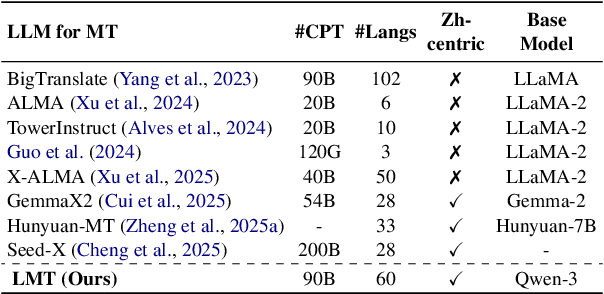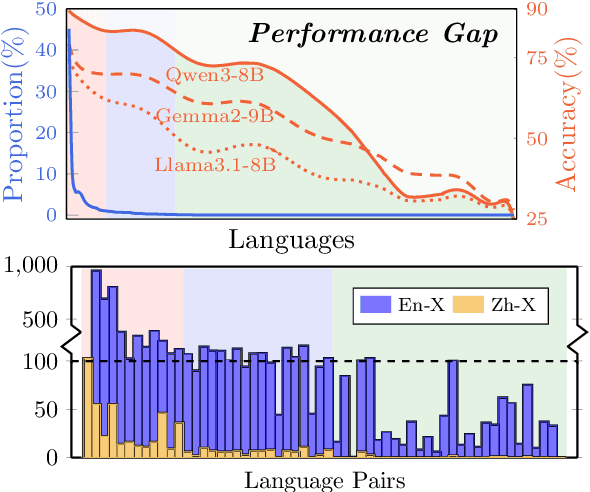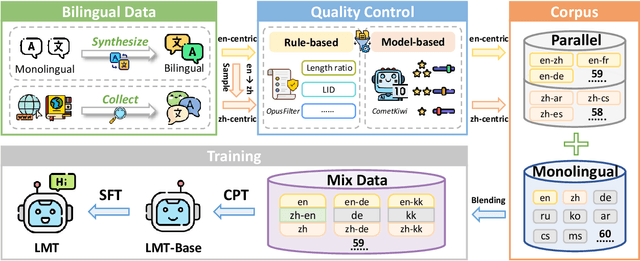Jingbo Zhu
Probing Preference Representations: A Multi-Dimensional Evaluation and Analysis Method for Reward Models
Nov 16, 2025Abstract:Previous methods evaluate reward models by testing them on a fixed pairwise ranking test set, but they typically do not provide performance information on each preference dimension. In this work, we address the evaluation challenge of reward models by probing preference representations. To confirm the effectiveness of this evaluation method, we construct a Multi-dimensional Reward Model Benchmark (MRMBench), a collection of six probing tasks for different preference dimensions. We design it to favor and encourage reward models that better capture preferences across different dimensions. Furthermore, we introduce an analysis method, inference-time probing, which identifies the dimensions used during the reward prediction and enhances its interpretability. Through extensive experiments, we find that MRMBench strongly correlates with the alignment performance of large language models (LLMs), making it a reliable reference for developing advanced reward models. Our analysis of MRMBench evaluation results reveals that reward models often struggle to capture preferences across multiple dimensions, highlighting the potential of multi-objective optimization in reward modeling. Additionally, our findings show that the proposed inference-time probing method offers a reliable metric for assessing the confidence of reward predictions, which ultimately improves the alignment of LLMs.
Beyond English: Toward Inclusive and Scalable Multilingual Machine Translation with LLMs
Nov 10, 2025



Abstract:Large language models have significantly advanced Multilingual Machine Translation (MMT), yet the broad language coverage, consistent translation quality, and English-centric bias remain open challenges. To address these challenges, we introduce \textbf{LMT}, a suite of \textbf{L}arge-scale \textbf{M}ultilingual \textbf{T}ranslation models centered on both Chinese and English, covering 60 languages and 234 translation directions. During development, we identify a previously overlooked phenomenon of \textbf{directional degeneration}, where symmetric multi-way fine-tuning data overemphasize reverse directions (X $\to$ En/Zh), leading to excessive many-to-one mappings and degraded translation quality. We propose \textbf{Strategic Downsampling}, a simple yet effective method to mitigate this degeneration. In addition, we design \textbf{Parallel Multilingual Prompting (PMP)}, which leverages typologically related auxiliary languages to enhance cross-lingual transfer. Through rigorous data curation and refined adaptation strategies, LMT achieves SOTA performance among models of comparable language coverage, with our 4B model (LMT-60-4B) surpassing the much larger Aya-101-13B and NLLB-54B models by a substantial margin. We release LMT in four sizes (0.6B/1.7B/4B/8B) to catalyze future research and provide strong baselines for inclusive, scalable, and high-quality MMT \footnote{\href{https://github.com/NiuTrans/LMT}{https://github.com/NiuTrans/LMT}}.
MRO: Enhancing Reasoning in Diffusion Language Models via Multi-Reward Optimization
Oct 24, 2025



Abstract:Recent advances in diffusion language models (DLMs) have presented a promising alternative to traditional autoregressive large language models (LLMs). However, DLMs still lag behind LLMs in reasoning performance, especially as the number of denoising steps decreases. Our analysis reveals that this shortcoming arises primarily from the independent generation of masked tokens across denoising steps, which fails to capture the token correlation. In this paper, we define two types of token correlation: intra-sequence correlation and inter-sequence correlation, and demonstrate that enhancing these correlations improves reasoning performance. To this end, we propose a Multi-Reward Optimization (MRO) approach, which encourages DLMs to consider the token correlation during the denoising process. More specifically, our MRO approach leverages test-time scaling, reject sampling, and reinforcement learning to directly optimize the token correlation with multiple elaborate rewards. Additionally, we introduce group step and importance sampling strategies to mitigate reward variance and enhance sampling efficiency. Through extensive experiments, we demonstrate that MRO not only improves reasoning performance but also achieves significant sampling speedups while maintaining high performance on reasoning benchmarks.
Deep Learning in Dental Image Analysis: A Systematic Review of Datasets, Methodologies, and Emerging Challenges
Oct 23, 2025



Abstract:Efficient analysis and processing of dental images are crucial for dentists to achieve accurate diagnosis and optimal treatment planning. However, dental imaging inherently poses several challenges, such as low contrast, metallic artifacts, and variations in projection angles. Combined with the subjectivity arising from differences in clinicians' expertise, manual interpretation often proves time-consuming and prone to inconsistency. Artificial intelligence (AI)-based automated dental image analysis (DIA) offers a promising solution to these issues and has become an integral part of computer-aided dental diagnosis and treatment. Among various AI technologies, deep learning (DL) stands out as the most widely applied and influential approach due to its superior feature extraction and representation capabilities. To comprehensively summarize recent progress in this field, we focus on the two fundamental aspects of DL research-datasets and models. In this paper, we systematically review 260 studies on DL applications in DIA, including 49 papers on publicly available dental datasets and 211 papers on DL-based algorithms. We first introduce the basic concepts of dental imaging and summarize the characteristics and acquisition methods of existing datasets. Then, we present the foundational techniques of DL and categorize relevant models and algorithms according to different DIA tasks, analyzing their network architectures, optimization strategies, training methods, and performance. Furthermore, we summarize commonly used training and evaluation metrics in the DIA domain. Finally, we discuss the current challenges of existing research and outline potential future directions. We hope that this work provides a valuable and systematic reference for researchers in this field. All supplementary materials and detailed comparison tables will be made publicly available on GitHub.
SUBQRAG: sub-question driven dynamic graph rag
Oct 09, 2025Abstract:Graph Retrieval-Augmented Generation (Graph RAG) effectively builds a knowledge graph (KG) to connect disparate facts across a large document corpus. However, this broad-view approach often lacks the deep structured reasoning needed for complex multi-hop question answering (QA), leading to incomplete evidence and error accumulation. To address these limitations, we propose SubQRAG, a sub-question-driven framework that enhances reasoning depth. SubQRAG decomposes a complex question into an ordered chain of verifiable sub-questions. For each sub-question, it retrieves relevant triples from the graph. When the existing graph is insufficient, the system dynamically expands it by extracting new triples from source documents in real time. All triples used in the reasoning process are aggregated into a "graph memory," forming a structured and traceable evidence path for final answer generation. Experiments on three multi-hop QA benchmarks demonstrate that SubQRAG achieves consistent and significant improvements, especially in Exact Match scores.
FLEXI: Benchmarking Full-duplex Human-LLM Speech Interaction
Sep 26, 2025Abstract:Full-Duplex Speech-to-Speech Large Language Models (LLMs) are foundational to natural human-computer interaction, enabling real-time spoken dialogue systems. However, benchmarking and modeling these models remains a fundamental challenge. We introduce FLEXI, the first benchmark for full-duplex LLM-human spoken interaction that explicitly incorporates model interruption in emergency scenarios. FLEXI systematically evaluates the latency, quality, and conversational effectiveness of real-time dialogue through six diverse human-LLM interaction scenarios, revealing significant gaps between open source and commercial models in emergency awareness, turn terminating, and interaction latency. Finally, we suggest that next token-pair prediction offers a promising path toward achieving truly seamless and human-like full-duplex interaction.
IIET: Efficient Numerical Transformer via Implicit Iterative Euler Method
Sep 26, 2025



Abstract:High-order numerical methods enhance Transformer performance in tasks like NLP and CV, but introduce a performance-efficiency trade-off due to increased computational overhead. Our analysis reveals that conventional efficiency techniques, such as distillation, can be detrimental to the performance of these models, exemplified by PCformer. To explore more optimizable ODE-based Transformer architectures, we propose the \textbf{I}terative \textbf{I}mplicit \textbf{E}uler \textbf{T}ransformer \textbf{(IIET)}, which simplifies high-order methods using an iterative implicit Euler approach. This simplification not only leads to superior performance but also facilitates model compression compared to PCformer. To enhance inference efficiency, we introduce \textbf{I}teration \textbf{I}nfluence-\textbf{A}ware \textbf{D}istillation \textbf{(IIAD)}. Through a flexible threshold, IIAD allows users to effectively balance the performance-efficiency trade-off. On lm-evaluation-harness, IIET boosts average accuracy by 2.65\% over vanilla Transformers and 0.8\% over PCformer. Its efficient variant, E-IIET, significantly cuts inference overhead by 55\% while retaining 99.4\% of the original task accuracy. Moreover, the most efficient IIET variant achieves an average performance gain exceeding 1.6\% over vanilla Transformer with comparable speed.
Attention2Probability: Attention-Driven Terminology Probability Estimation for Robust Speech-to-Text System
Aug 26, 2025Abstract:Recent advances in speech large language models (SLMs) have improved speech recognition and translation in general domains, but accurately generating domain-specific terms or neologisms remains challenging. To address this, we propose Attention2Probability: attention-driven terminology probability estimation for robust speech-to-text system, which is lightweight, flexible, and accurate. Attention2Probability converts cross-attention weights between speech and terminology into presence probabilities, and it further employs curriculum learning to enhance retrieval accuracy. Furthermore, to tackle the lack of data for speech-to-text tasks with terminology intervention, we create and release a new speech dataset with terminology to support future research in this area. Experimental results show that Attention2Probability significantly outperforms the VectorDB method on our test set. Specifically, its maximum recall rates reach 92.57% for Chinese and 86.83% for English. This high recall is achieved with a latency of only 8.71ms per query. Intervening in SLMs' recognition and translation tasks using Attention2Probability-retrieved terms improves terminology accuracy by 6-17%, while revealing that the current utilization of terminology by SLMs has limitations.
LaTeXTrans: Structured LaTeX Translation with Multi-Agent Coordination
Aug 26, 2025Abstract:Despite the remarkable progress of modern machine translation (MT) systems on general-domain texts, translating structured LaTeX-formatted documents remains a significant challenge. These documents typically interleave natural language with domain-specific syntax, such as mathematical equations, tables, figures, and cross-references, all of which must be accurately preserved to maintain semantic integrity and compilability. In this paper, we introduce LaTeXTrans, a collaborative multi-agent system designed to address this challenge. LaTeXTrans ensures format preservation, structural fidelity, and terminology consistency through six specialized agents: 1) a Parser that decomposes LaTeX into translation-friendly units via placeholder substitution and syntax filtering; 2) a Translator, Validator, Summarizer, and Terminology Extractor that work collaboratively to ensure context-aware, self-correcting, and terminology-consistent translations; 3) a Generator that reconstructs the translated content into well-structured LaTeX documents. Experimental results demonstrate that LaTeXTrans can outperform mainstream MT systems in both translation accuracy and structural fidelity, offering an effective and practical solution for translating LaTeX-formatted documents.
One Size Does Not Fit All: A Distribution-Aware Sparsification for More Precise Model Merging
Aug 08, 2025Abstract:Model merging has emerged as a compelling data-free paradigm for multi-task learning, enabling the fusion of multiple fine-tuned models into a single, powerful entity. A key technique in merging methods is sparsification, which prunes redundant parameters from task vectors to mitigate interference. However, prevailing approaches employ a ``one-size-fits-all'' strategy, applying a uniform sparsity ratio that overlooks the inherent structural and statistical heterogeneity of model parameters. This often leads to a suboptimal trade-off, where critical parameters are inadvertently pruned while less useful ones are retained. To address this limitation, we introduce \textbf{TADrop} (\textbf{T}ensor-wise \textbf{A}daptive \textbf{Drop}), an adaptive sparsification strategy that respects this heterogeneity. Instead of a global ratio, TADrop assigns a tailored sparsity level to each parameter tensor based on its distributional properties. The core intuition is that tensors with denser, more redundant distributions can be pruned aggressively, while sparser, more critical ones are preserved. As a simple and plug-and-play module, we validate TADrop by integrating it with foundational, classic, and SOTA merging methods. Extensive experiments across diverse tasks (vision, language, and multimodal) and models (ViT, BEiT) demonstrate that TADrop consistently and significantly boosts their performance. For instance, when enhancing a leading merging method, it achieves an average performance gain of 2.0\% across 8 ViT-B/32 tasks. TADrop provides a more effective way to mitigate parameter interference by tailoring sparsification to the model's structure, offering a new baseline for high-performance model merging.
 Add to Chrome
Add to Chrome Add to Firefox
Add to Firefox Add to Edge
Add to Edge